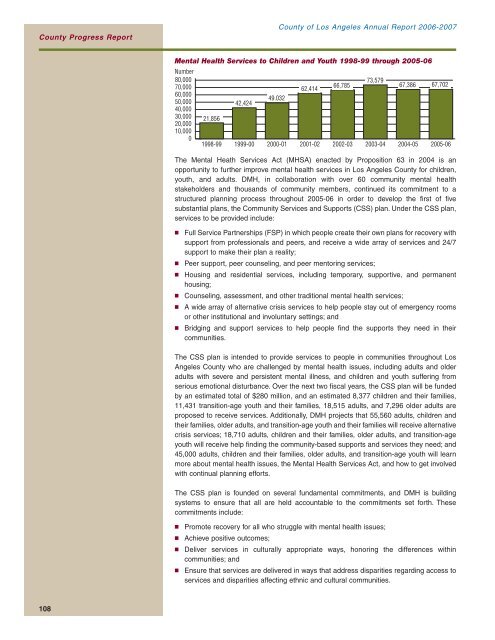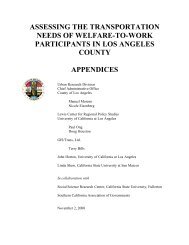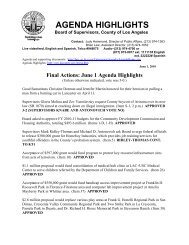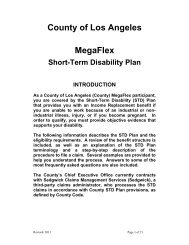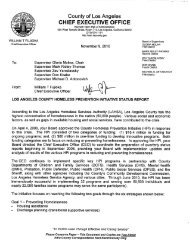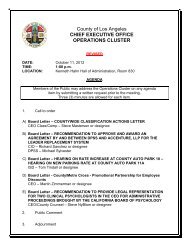Annual Report - Chief Executive Office - Los Angeles County
Annual Report - Chief Executive Office - Los Angeles County
Annual Report - Chief Executive Office - Los Angeles County
Create successful ePaper yourself
Turn your PDF publications into a flip-book with our unique Google optimized e-Paper software.
<strong>County</strong> Progress <strong>Report</strong><br />
108<br />
<strong>County</strong> of <strong>Los</strong> <strong>Angeles</strong> <strong>Annual</strong> <strong>Report</strong> 2006-2007<br />
Mental Health Services to Children and Youth 1998-99 through 2005-06<br />
Number<br />
80,000<br />
70,000<br />
60,000<br />
50,000<br />
40,000<br />
30,000<br />
20,000<br />
10,000<br />
0<br />
21,856<br />
1998-99<br />
42,424<br />
1999-00<br />
49.032<br />
2000-01<br />
62,414<br />
2001-02<br />
66,785<br />
2002-03<br />
73,579<br />
2003-04<br />
67,386 67,702<br />
2004-05<br />
2005-06<br />
The Mental Heath Services Act (MHSA) enacted by Proposition 63 in 2004 is an<br />
opportunity to further improve mental health services in <strong>Los</strong> <strong>Angeles</strong> <strong>County</strong> for children,<br />
youth, and adults. DMH, in collaboration with over 60 community mental health<br />
stakeholders and thousands of community members, continued its commitment to a<br />
structured planning process throughout 2005-06 in order to develop the first of five<br />
substantial plans, the Community Services and Supports (CSS) plan. Under the CSS plan,<br />
services to be provided include:<br />
Full Service Partnerships (FSP) in which people create their own plans for recovery with<br />
support from professionals and peers, and receive a wide array of services and 24/7<br />
support to make their plan a reality;<br />
Peer support, peer counseling, and peer mentoring services;<br />
Housing and residential services, including temporary, supportive, and permanent<br />
housing;<br />
Counseling, assessment, and other traditional mental health services;<br />
A wide array of alternative crisis services to help people stay out of emergency rooms<br />
or other institutional and involuntary settings; and<br />
Bridging and support services to help people find the supports they need in their<br />
communities.<br />
The CSS plan is intended to provide services to people in communities throughout <strong>Los</strong><br />
<strong>Angeles</strong> <strong>County</strong> who are challenged by mental health issues, including adults and older<br />
adults with severe and persistent mental illness, and children and youth suffering from<br />
serious emotional disturbance. Over the next two fiscal years, the CSS plan will be funded<br />
by an estimated total of $280 million, and an estimated 8,377 children and their families,<br />
11,431 transition-age youth and their families, 18,515 adults, and 7,296 older adults are<br />
proposed to receive services. Additionally, DMH projects that 55,560 adults, children and<br />
their families, older adults, and transition-age youth and their families will receive alternative<br />
crisis services; 18,710 adults, children and their families, older adults, and transition-age<br />
youth will receive help finding the community-based supports and services they need; and<br />
45,000 adults, children and their families, older adults, and transition-age youth will learn<br />
more about mental health issues, the Mental Health Services Act, and how to get involved<br />
with continual planning efforts.<br />
The CSS plan is founded on several fundamental commitments, and DMH is building<br />
systems to ensure that all are held accountable to the commitments set forth. These<br />
commitments include:<br />
Promote recovery for all who struggle with mental health issues;<br />
Achieve positive outcomes;<br />
Deliver services in culturally appropriate ways, honoring the differences within<br />
communities; and<br />
Ensure that services are delivered in ways that address disparities regarding access to<br />
services and disparities affecting ethnic and cultural communities.


